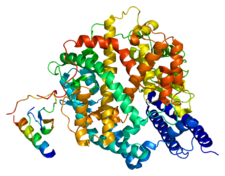User:Letícia Oliveira Rojas Cruz/Sandbox 1
From Proteopedia
(Difference between revisions)
| Line 20: | Line 20: | ||
== Physiological Function == | == Physiological Function == | ||
| - | <scene name='10/1083732/Ace2_completa/3'>ACE2</scene> is a transmembrane glycoprotein that has an extracellular catalytic domain. It is classified as a hydrolase, more specifically a carboxypeptidase-type peptidase, responsible for the cleavage of peptide bonds at the C-terminal site. | + | <scene name='10/1083732/Ace2_completa/3'>ACE2</scene> is a transmembrane glycoprotein that has an extracellular catalytic domain. It is classified as a hydrolase, more specifically a carboxypeptidase-type peptidase, responsible for the cleavage of peptide bonds at the C-terminal site. <ref>PMID:17897633</ref> |
The ACE2 acts to cleave a single C-terminal residue of some substrates. One of those substrates is Angiotensin II (Ang II), which is degrated into Angiotensin-(1-7); to a lesser extent, Angiotensin I (Ang I) is also a substrate, turning in into Angiotensin-(1-9). | The ACE2 acts to cleave a single C-terminal residue of some substrates. One of those substrates is Angiotensin II (Ang II), which is degrated into Angiotensin-(1-7); to a lesser extent, Angiotensin I (Ang I) is also a substrate, turning in into Angiotensin-(1-9). | ||
The Renin-Angiotensin System - "RAS" -, in which ACE2 acts, is an important signaling pathway responsible for vascular homeostasis. | The Renin-Angiotensin System - "RAS" -, in which ACE2 acts, is an important signaling pathway responsible for vascular homeostasis. | ||
| - | In general, Ang II, generated by the action of ACE on Ang I, and this one by the action of Renin on Angiotensinogen, acts on AT1 and AT2 receptors. Its main action is vasoconstriction (by AT1 receptor), increasing blood pressure. On the other hand, Angiotensin (1-7), generated from Ang II by ACE2, has the opposite function, leading to a decline in blood pressure through vasodilation and release of Nitric Oxide (NO) through its action on the MAS oncogene receptor, antagonizing the actions of Ang II. | + | In general, Ang II, generated by the action of ACE on Ang I, and this one by the action of Renin on Angiotensinogen, acts on AT1 and AT2 receptors. Its main action is vasoconstriction (by AT1 receptor), increasing blood pressure. On the other hand, Angiotensin (1-7), generated from Ang II by ACE2, has the opposite function, leading to a decline in blood pressure through vasodilation and release of Nitric Oxide (NO) through its action on the MAS oncogene receptor, antagonizing the actions of Ang II. <ref>PMID:19461648</ref> |
== Pathological Relevance == | == Pathological Relevance == | ||
The ACE2 protein became better known and widely publicized in 2020 due to its role in the infection by '''SARS-CoV-2''', the virus responsible for the Covid-19 pandemic. | The ACE2 protein became better known and widely publicized in 2020 due to its role in the infection by '''SARS-CoV-2''', the virus responsible for the Covid-19 pandemic. | ||
| - | In this disease, ACE2 acts as a viral receptor, to which the Spike (S) viral protein binds, promoting the entry of the virus into the host cell. The specific region of the S protein responsible for binding to the ACE2 receptor is called '''receptor-binding domain (RBD)''', and is located in the S1 subunit of the Spike protein. | + | In this disease, ACE2 acts as a viral receptor, to which the Spike (S) viral protein binds, promoting the entry of the virus into the host cell. The specific region of the S protein responsible for binding to the ACE2 receptor is called '''receptor-binding domain (RBD)''', and is located in the S1 subunit of the Spike protein. <ref>PMID:32142651</ref> |
== Structure highlights == | == Structure highlights == | ||
| Line 51: | Line 51: | ||
=== SARS-CoV-2 Binding === | === SARS-CoV-2 Binding === | ||
'''{{Font color|crimson|ACE2}}''' <scene name='10/1083732/Sars_cov_2/2'>binds</scene> to the '''{{Font color|darkmagenta|Spike (S)}}''' glycoprotein of the SARS-CoV-2 virus, promoting its internalization into the cell. More specifically, binding occurs between the PD subunit of ACE2 and the receptor binding domain (RBD) of the S1 subunit of the S protein. Each PD binds to an RBD by polar bonds, with one ACE2 dimer accommodating two S protein trimers. | '''{{Font color|crimson|ACE2}}''' <scene name='10/1083732/Sars_cov_2/2'>binds</scene> to the '''{{Font color|darkmagenta|Spike (S)}}''' glycoprotein of the SARS-CoV-2 virus, promoting its internalization into the cell. More specifically, binding occurs between the PD subunit of ACE2 and the receptor binding domain (RBD) of the S1 subunit of the S protein. Each PD binds to an RBD by polar bonds, with one ACE2 dimer accommodating two S protein trimers. | ||
| + | |||
== References == | == References == | ||
| - | + | <references/> | |
| + | |||
HOFFMANN, M. et al. SARS-CoV-2 Cell Entry Depends on ACE2 and TMPRSS2 and Is Blocked by a Clinically Proven Protease Inhibitor. Cell, v. 181, n. 2, p. 271–280, mar. 2020. | HOFFMANN, M. et al. SARS-CoV-2 Cell Entry Depends on ACE2 and TMPRSS2 and Is Blocked by a Clinically Proven Protease Inhibitor. Cell, v. 181, n. 2, p. 271–280, mar. 2020. | ||
Revision as of 18:07, 8 July 2025
Angiotensin-converting enzyme 2 (ACE2)
| |||||||||||

